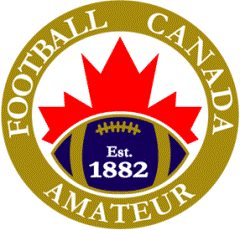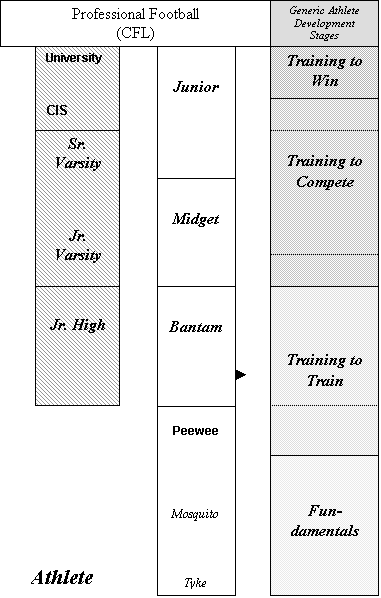Football
Canada
Athlete
Development Model
Last Amended Date June 8, 2004
Purpose
of the Model:
This
model is a dynamic and inclusive planning tool that is a working
guideline for the development of football players across Canada. Although it is the intent of the model to assist in
providing an integrated sport system for football, it will be
necessary to revise and update specific content over time.
Football Canada will use this model as a foundation document to
guide the implementation of athlete development, coaching programs,
and competition considerations. Provincial
and affiliated organizations, community based clubs and school
programs are encouraged to use this document as a template that can be
adapted to provincial and local needs.
Rationale:
The
model examines all aspects of football and is divided tackle and touch
/ flag football considerations and is adapted from Istvan Balyi's
long-term athlete development principles.
The model recognizes athletes with disabilities at the
introductory stages and provides opportunities for gender
inclusiveness where appropriate.
The touch and flag games provide access to participation at the
entry level, but also as an alternative to tackle football at the
later stages of development. The
ideal progression for elite athlete development is identified in the
model, examining each stage of development from the introduction of
football to the completion of one's playing career.
While the model provides a pathway for chronological age, it is
important to recognize that this is not always the best indicator of
an athletes development, instead a training age is provided that
accounts for athlete maturation.
It is therefore important to recognize the flexibility for
players who enter the football model later in their athletic
development. In these
circumstances late entry athlete may progress through a developmental
stage at a faster rate based on previous athletic experience, however,
it is important that skill components a preceding stages of
development are progressed in an optimal fashion.
In the tackle
considerations of the model, game modifications are suggested at the
Fundamental and Training stages where static defenses are encouraged
in order to maximize skill development.
Tackle
Football Athlete Development Overview
|
|
|
Fundamentals
|
Training
/ Practice
|
Competition
|
Elite
Performance
|
|
Age Range
|
·
12 & under
·
(0-4 training years)
|
·
11 16
·
(1-4 training years)
|
·
16 19+
·
(4-8 training years)
|
·
18 +
·
(8+ training years)
|
|
Participation
|
·
Co-ed, Physical / Mental Disabilities
|
·
Early: Coed
Predominantly male. Physical / Mental Disabilities
·
Late: Male and
female teams in certain regions by gender
|
·
Predominantly Male.
|
·
Predominantly male.
|
|
Selection
|
·
Overall positional selection (size considerations where
appropriate, to ensure participation and safety.
|
·
Positional selection considered based on strength / speed,
ability, size.
|
·
Positional Selection consideration based on strength /
speed, ability, size.
·
Based on basic fitness testing
·
Self and coach selection
·
General talent identification
|
·
Based on specific fitness testing
·
Talent identify position considerations
·
Selection for team considerations
|
|
Degree of
specialization
|
·
Acquisition of basic skills for all players.
·
Offensive & defensive positions basic introduction
to positional play
|
·
Lineman
·
Inside Backs Skills (Eg. Linebackers / Offensive backs)
·
Outside Backs Skills (Eg. Receivers, Defensive backs)
|
·
Increased opportunity to specialize in offensive and
defensive roles.
·
Offensive
o
Linemen
o
Back field
o
Receiver
·
Defensive
o
Linemen
o
Linebacker
o
Defensive back
|
·
Offensive Line
o
Guard, Centre, Tackles
·
Backfield
o
Quarterbacks, Running Backs
·
Receivers
o
Inside receivers,
Outside receivers, Tight ends
·
Linebackers
o
Outside, Inside, Middle
·
Defensive backs
o
Corner,
Safety, Half back
·
Defensive Line
o
Inside, outside
·
Kickers
o
Place, Punt
·
Special Teams
|
|
Game
Modifications
|
·
Canadian Rules: Time, kicking, blocking, down &
distance, field size, ball size, game time, weight restrictions,
team size. systems
modifications in order to learn the basic skills of the game as
per House league.
·
Defense is static: No
Stunts, blitz or penetration Man on Man defense.
·
Blocking only above the waist.
·
Reduce number of players on field during competitions, if
possible.
·
Option of using flag football @ this level.
|
·
Canadian Rules: Tackle
Rule book
·
House league rules are adopted for regions and age:
Field size, Ball size, game time, weight restrictions, team
size.
·
Opportunities to play other versions of the game (flag or
touch) create ongoing possibilities for participation.
·
Early: Defense
is static: No Stunts,
blitz or penetration Man on Man defense.
·
Blocking only above the waist.
|
·
Canadian Rules: Tackle
rule book. House
league rules are adopted in different regions Eg. Length of
game time
|
·
Canadian Rules: Variations
between CIS, Junior and Professional.
Adoption of rules will be specialized to context
|
|
Football
Structure
|
·
Community: Tyke, Mosquito, lower Peewee.
|
·
Schools: Jr
High Jr varsity
·
Community: Peewee,
Bantam, Early Midget.
|
·
Schools: Senior
Varsity Early CIS
·
Community: Late midget Early Junior
|
·
CIS: 3 5 year
·
Junior: Later
Years
·
Professional
|
|
Competition
(Number /
Importance)
|
·
Limited Importance
·
Everyone plays the outcome is motivational
·
Up to 10 games maximum.
·
Tournaments/Jamborees.
|
·
Limited Importance (Varies for later football structures)
·
Peaking: None to one
·
Maximize participation Every one has access to play the
game*
·
8-12 games
|
·
Important (Peaking towards Playoffs late season)
·
8-12 games
|
·
Very Important (Peak and Taper for each competition)
·
10-12 games*
|
|
Length of
Season
|
·
·
Competitive Season 8-12 weeks (includes
skills/introduction/training period)
|
·
Pre-season skills introduction/training period (3 6
weeks (no competitions)
·
Competitive Season - 10-14 weeks -
(peewee, bantams & midgets)
|
·
10-12 weeks
·
Pre-season 2 weeks
|
·
10 - 16 weeks (CIS / Junior)
·
20 + (Pro)
·
12 Month Annual planning
|
|
Number of
Practices
|
·
2-3/week
|
·
3 per/week maximum
·
1 game/week (normally weekends)
·
Skills Camps
|
·
2 days off / week
·
3-4 on-field practices / week
·
Meetings: 1-2 / week
·
Pre-season: 1-2
practices per day (5 day cycle) Two a day on-field
practices not to exceed 3 hours in total time
·
Skills Camps
|
·
In competition: 3-5
on-field practices / week
·
Pre season: 12
18 on-field practices / 2 weeks (varying intensity of two a
day practices should be considered)
·
Meetings: 3-5
/ week
·
Walk throughs
|
|
Length of
Practices
|
·
1.0 1.5 hourrs
|
·
1.5 - 2 hours
|
·
1.5 - 2 hours
|
·
Practice: 1.5
2.5 hours
·
Meetings: 30 min 1.5 hours
|
|
Impact
|
·
Recruit and retain participation
·
Strong regional leagues and organization
·
Involvement of parents (more MOMs and dads)
|
·
Recruit and retain of participation
·
Strong community and school leagues programs (Positive
experiences)
·
Better recruitment and retention of competent coaches
(trained and certified)
|
·
Retain participation
·
Strong community and school leagues programs
·
National championships with representation from all regions
(Canada Cup)
·
Better recruitment and retention of competent coaches
(trained and certified)
|
·
Selection and identification of quality players
·
Retention and expansion of teams at CIS.
·
High visibility of programs in general public.
·
Better recruitment and retention of competent coaches
(trained and certified)
|
|
|
*Appropriate equipment to meet the age group needs &
availability of coaches.
|
*Amount of equipment may be a limiting factor on
participation.
|
|
*Top teams in CIS tend to be favoured with more
competitions
|







